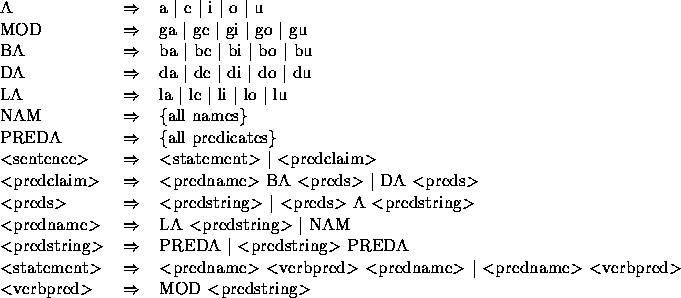当前你的浏览器版本过低,网站已在兼容模式下运行,兼容模式仅提供最小功能支持,网站样式可能显示不正常。
请尽快升级浏览器以体验网站在线编辑、在线运行等功能。
1631:Loglan-A Logical Language
题目描述
Loglan is a synthetic speakable language designed to test some of the fundamental problems of linguistics, such as the Sapir Whorf hypothesis. It is syntactically unambiguous, culturally neutral and metaphysically parsimonious. What follows is a gross over-simplification of an already very small grammar of some 200 rules.
Loglan sentences consist of a series of words and names, separated by spaces, and are terminated by a period (.). Loglan words all end with a vowel; names, which are derived extra-linguistically, end with a consonant. Loglan words are divided into two classes--little words which specify the structure of a sentence, and predicates which have the form CCVCV or CVCCV where C represents a consonant and V represents a vowel (see examples later).
The subset of Loglan that we are considering uses the following grammar:

Write a program that will read a succession of strings and determine whether or not they are correctly formed Loglan sentences.
Loglan sentences consist of a series of words and names, separated by spaces, and are terminated by a period (.). Loglan words all end with a vowel; names, which are derived extra-linguistically, end with a consonant. Loglan words are divided into two classes--little words which specify the structure of a sentence, and predicates which have the form CCVCV or CVCCV where C represents a consonant and V represents a vowel (see examples later).
The subset of Loglan that we are considering uses the following grammar:

Write a program that will read a succession of strings and determine whether or not they are correctly formed Loglan sentences.
输入解释
Each Loglan sentence will start on a new line and will be terminated by a period (.). The sentence may occupy more than one line and words may be separated by more than one whitespace character. The input will be terminated by a line containing a single `#'. You can assume that all words will be correctly formed.
Output will consist of one line for each sentence containing either `Good' or `Bad!'.
Output will consist of one line for each sentence containing either `Good' or `Bad!'.
输入样例
la mutce bunbo mrenu bi ditca. la fumna bi le mrenu. djan ga vedma le negro ketpi. #
输出样例
Good Bad! Good
来自杭电HDUOJ的附加信息
| Recommend | LL |
最后修改于 2020-10-25T22:46:39+00:00 由爬虫自动更新
共提交 144 次
通过率 47.22%
| 时间上限 | 内存上限 |
| 2000/1000MS(Java/Others) | 65536/32768K(Java/Others) |
登陆或注册以提交代码